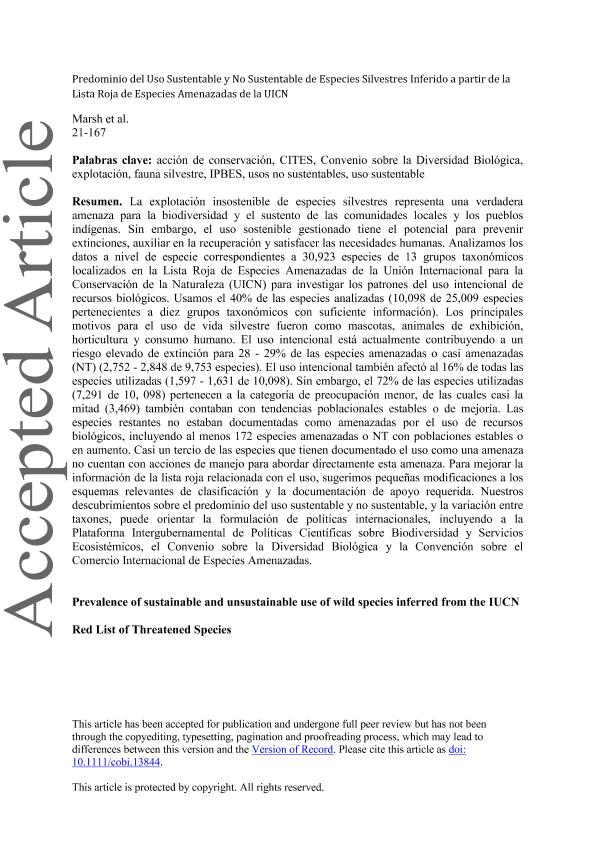Artículo
Prevalence of sustainable and unsustainable use of wild species inferred from the IUCN Red List of Threatened Species
Marsh, Sophie M. E.; Hoffmann, Michael; Burgess, Neil D.; Brooks, Thomas M.; Challender, Daniel W. S.; Cremona, Patricia J.; Hilton Taylor, Craig; de Micheaux, Flore Lafaye; Lichtenstein, Gabriela ; Roe, Dilys; Böhm, Monika
; Roe, Dilys; Böhm, Monika
 ; Roe, Dilys; Böhm, Monika
; Roe, Dilys; Böhm, Monika
Fecha de publicación:
10/2021
Editorial:
Wiley Blackwell Publishing, Inc
Revista:
Conservation Biology
ISSN:
0888-8892
Idioma:
Inglés
Tipo de recurso:
Artículo publicado
Clasificación temática:
Resumen
Unsustainable exploitation of wild species represents a serious threat to biodiversity and to the livelihoods of local communities and Indigenous peoples. However, managed, sustainable use has the potential to forestall extinctions, aid recovery, and meet human needs. We analyzed species-level data for 30,923 species from 13 taxonomic groups on the International Union for Conservation of Nature Red List of Threatened Species to investigate patterns of intentional biological resource use. Forty percent of species (10,098 of 25,009 species from 10 data-sufficient taxonomic groups) were used. The main purposes of use were pets, display animals, horticulture, and human consumption. Intentional use is currently contributing to elevated extinction risk for 28–29% of threatened or near threatened (NT) species (2752–2848 of 9753 species). Intentional use also affected 16% of all species used (1597–1631 of 10,098). However, 72% of used species (7291 of 10,098) were least concern, of which nearly half (3469) also had stable or improving population trends. The remainder were not documented as threatened by biological resource use, including at least 172 threatened or NT species with stable or improving populations. About one-third of species that had use documented as a threat had no targeted species management actions to directly address this threat. To improve use-related red-list data, we suggest small amendments to the relevant classification schemes and required supporting documentation. Our findings on the prevalence of sustainable and unsustainable use, and variation across taxa, can inform international policy making, including the Intergovernmental Science-Policy Platform on Biodiversity and Ecosystem Services, the Convention on Biological Diversity, and the Convention on International Trade in Endangered Species.
Palabras clave:
ACCIÓN DE CONSERVACIÓN
,
CITES
,
CITES
,
CONSERVATION ACTION
,
CONVENIO SOBRE LA DIVERSIDAD BIOLÓGICA
,
CONVENTION ON BIOLOGICAL DIVERSITY
,
EXPLOITATION
,
EXPLOTACIÓN
,
FAUNA SILVESTRE
,
IPBES
,
IPBES
,
SUSTAINABLE USE
,
UNSUSTAINABLE USES
,
USO SUSTENTABLE
,
USOS NO SUSTENTABLES
,
WILDLIFE
Archivos asociados
Licencia
Identificadores
Colecciones
Articulos(SEDE CENTRAL)
Articulos de SEDE CENTRAL
Articulos de SEDE CENTRAL
Citación
Marsh, Sophie M. E.; Hoffmann, Michael; Burgess, Neil D.; Brooks, Thomas M.; Challender, Daniel W. S.; et al.; Prevalence of sustainable and unsustainable use of wild species inferred from the IUCN Red List of Threatened Species; Wiley Blackwell Publishing, Inc; Conservation Biology; 36; 2; 10-2021; 1-35
Compartir
Altmétricas



